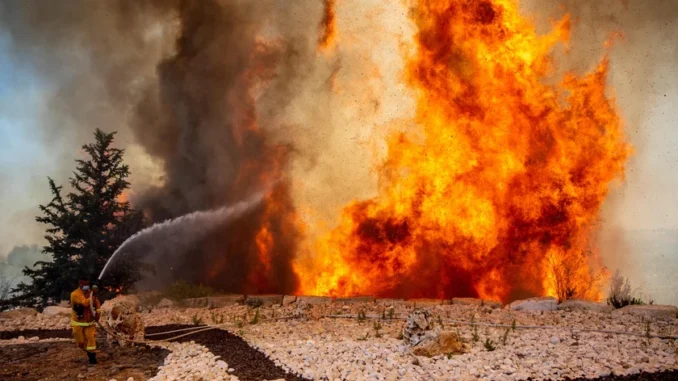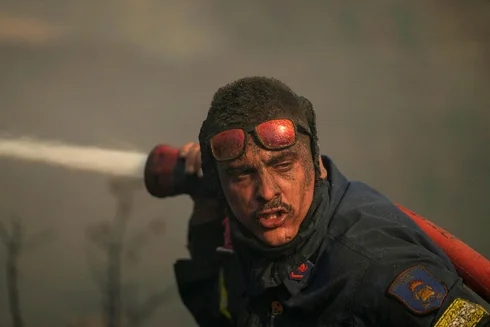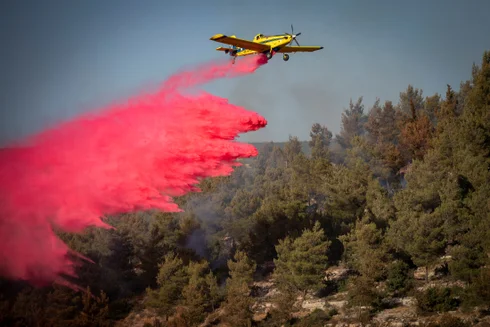T. Belman. At first the climate crises denoted rising oceans and now the big scare is burning forests. Is there any truth to either? Even if true, will banning of fossil fuels make a significant difference.
According to sources in Israel’s firefighting service, the organization lacks hundreds of millions of shekels in personnel and equipment needed to effectively deal with the anticipated fires
By Lee Yaron, HAARETZ 25.7.22
Firefighter battling flames in the Jerusalem hills in 2021.Credit: Ohad Zwigenberg
The climate crisis is expected to cause an increase in massive wildfires in Israel, particularly in populated areas, which will constitute “immediate danger to life and property,” according to a special climate crisis committee of the Israel Fire and Rescue Services. The frequency and intensity of the fires may cause the collapse of the firefighting system, which will be unable to cope, warns the committee.
Sources at the firefighting service say the organization is short hundreds of millions of shekels in human resources and equipment needed to effectively deal with the expected fires.
Official committee documents obtained by Haaretz state that “the climate crisis will lead to an increase in unstoppable massive wildfires in Israel.” The committee further wrote that “A significant increase in wildfires is expected throughout the Mediterranean basin. Therefore, reliance on international assistance may prove to be impractical.”
A firefighter sprays water at a fire on the mount of Penteli in Greece, last Tuesday.Credit: Thanassis Stavrakis /AP
In addition, the documents state that “in light of the expected scenarios and the needs for far greater operational continuity, Fire and Rescue might collapse due to the difficulty in providing an operational solution over time. The State of Israel is located in a particularly sensitive region, both in climate and geopolitical terms. Each day that passes without overall preparation, both in changing the allocation scenarios and through a change in mindset and a matching operational response, leads us to the brink of disaster.”
The committee was established three months ago by incoming firefighting commissioner Eyal Caspi, to examine the readiness of the firefighting service for developing challenges, with an emphasis on the climate crisis. Among its members were senior firefighting personnel as well as high-ranking officials at the Public Security Ministry and the Meteorological Service. The committee was headed by Nissim Twito, who runs the firefighting service’s operations division, and was Jerusalem district chief during the huge fire there last year. “The great danger we will have to face in coming years is an increase in the intensity and number of massive wildfires. We are on borrowed time and the question is not will it come, but when,” Twito told Haaretz.Open gallery view
Following the committee’s conclusions, Caspi instructed his staff in recent weeks to rank the climate crisis as the top threat facing Israeli’s firefighting forces – one requiring redirection of resources. Sources familiar with the issue, both inside the firefighting services and outside of it, told Haaretz that there are enormous gaps between the projected scenarios and the firefighting services’ current readiness to face them. Thus, for example, the service says it will require 3,400 firefighters to deal with the expected massive fires, as opposed to the current force of 2,260 firefighters – but the Finance Ministry and the Civil Service Commission have not allocated the additional positions. The service estimates that it needs 150 fire stations, as opposed to the existing 126, and also that it needs 657 fire engines, with 582 currently in service. No comment was received from Public Security Minister Omer Bar-Lev by time of publication.
According to Twito, “We understand that the fires in France and Portugal today are our future.” And indeed, parts of France, Spain, and Portugal have seen more land burn down this year than in all of 2021. Last week the European Union published new data showing that over the past years, due to the climate crisis, EU countries have experienced the worst wildfires on record within their borders, and that the current drought throughout the continent may turn into the worst ever recorded. The extent of land burned down in Europe this year has tripled – some 4.5 million dunams (1.125 million acres) had burned down by July 16, compared to an average of 1.1 million dunams from 2006-2021. By mid-July this year nearly 1,900 wildfires raged throughout Europe, compared to an average of 470 fires a year from 2006-2021.
- 1,600 dead, temperature records broken as European heat wave expands
- Four years after pledge, Israel finally funds climate forecast tech
- Heat waves killed hundreds of Israelis in a decade, study finds
Climate scientists explain that hotter temperatures, along with almost unprecedented drought conditions throughout Europe and a shortening of the rainy season, contribute to drying the forests and create the ideal conditions for the start and spread of wildfires. These conditions impact other regions in the world, such as California, where climate change has turned the western United States hotter and dryer over the past 30 years, leading to more and deadlier wildfires. Just last Saturday, thousands of residents were ordered to evacuate due to a large brush fire raging near Yosemite National Park.
In Israel, a report by Dr. Amir Givati of Tel Aviv University for the firefighting service shows that from 1986-2019 the potential for the spread of wildfires in the Jerusalem Hills region increased 22 percent from climate change factors alone – unrelated to additional danger from land use and population growth.
Forces in Israel are coming to the realization that the most important firefighting tools needed are systems capable of predicting the outbreak and spread of fire in real time, allowing forces to deploy in large numbers before the situation becomes unmanageable. Back in 2013 the Public Security Ministry announced that a fire prediction system, developed as a result of conclusions drawn from the 2010 Carmel Fire “provides the solution.” But the firefighting service decommissioned the system, as it was found to be unreliable. In October 2018, the Public Security Ministry announced a bid for a new system to provide firefighters with real-time data on the direction in which fires are spreading. Some three months ago, after settling disputes between the firefighting services and the meteorological service, and after a cumulative delay of nine years, the new system finally entered “operational testing.”







easier to get rid of arab arsonists than to change climate
How closely are the responsible authorities monitoring the hostile Muslim enclaves created by hidden roads and tunnels that make it difficult for the average person to see? Israel has created a swiss-cheese map that gives the Pals “transportational contiguity” that the wiseacres in the “professional security” cult think will nullify the Pals’ bloodlust for “territorial contiguity.”
Thanks for the link.
So much for “scientists”.
Thanks go to Tony Heller, who first collected many of these news clips and posted them on RealClimateScience.
SUMMARY
https://cei.org/blog/wrong-again-50-years-of-failed-eco-pocalyptic-predictions/